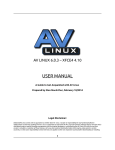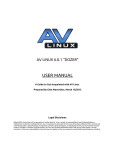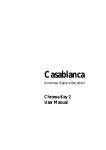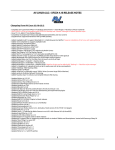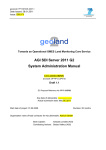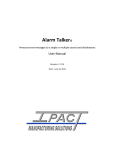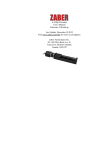Download USER MANUAL - Bandshed.net
Transcript
AV LINUX 6.0.2 – XFCE4 4.10 USER MANUAL A Guide to Get Acquainted with AV Linux Prepared by Glen MacArthur, December 10/2013 Legal Disclaimer: Debian/GNU Linux comes with no guarantee so neither does AV Linux. I accept no responsibility for any hardware/software malfunctions or data loss resulting from it's use. It is important to note that the AV Linux ISO contains software that is non-free and is distributed under a special licensing arrangement with the original developers, re-distributing the AV Linux ISO with the non-free content included is a violation of these licenses. AV Linux also contains Multimedia Codecs that may be under patent in certain countries, it is the users responsibility to know the law as it applies to their own respective country before downloading or installing. 1 TABLE OF CONTENTS: • • • • • • • • • • • • • • • • • • • • • • • • • • • Page 3. - PREFACE Page 4. - THE AV LINUX STORY Page 5. - CREDITS & CONTACT Page 6. - THE CONCEPT OF AV LINUX Page 7. - RUNNING AV LINUX LIVE Page 10. - AV LINUX BASIC BOOTING BIBLE Page 11. - INSTALLING AV LINUX Page 12. - GETTING AROUND IN AV LINUX Page 22. - SliM LOGIN MANAGER Page 23. - PERFORMANCE SETTINGS Page 24. - PROPRIETARY VIDEO DRIVERS IN AV LINUX Page 30. - MONITOR AND DISPLAY SETTINGS Page 32. - COMPIZ WINDOW MANAGER Page 33. - AV LINUX KERNELS Page 34. - KERNEL CHEATCODES Page 35. - AV LINUX SOFTWARE Page 37. - INSTALLING SOFTWARE IN AV LINUX Page 40. - WHERE TO FIND UPDATED PACKAGES Page 41. - NETWORKING WITH AV LINUX Page 46. - PRINTING WITH AV LINUX Page 47. - USING JACK Page 49. - MANAGING MIDI IN AV LINUX Page 50. - USING THE ALOOP DAEMON Page 51. - M-AUDIO 1010LT PCM_MULTI WITH AV LINUX Page 53. - DEBIAN REFERENCE Page 56. - HANDY TERMINAL COMMANDS Page 57. - THANKS FOR SUPPORTING AV LINUX 2 PREFACE – NEW TO LINUX ? Realistic Expectations of what AV Linux Can Offer: AV Linux is an ISO Image created with Debian/GNU Linux. Despite it's critics Linux continues to grow it's user base year after year and has seen great strides in both the quality and number of Software Applications. There are many positive attributes to Linux and 'FLOSS' (Free Libre Open Source Software) and the grassroots community-based development model is completely unique when compared to the Apple and Windows corporate paradigms. To be blunt the notion that Linux of any kind is either better or worse than any other computer Operating System is to miss the point somewhat and serves to set the user up for unrealistic expectations and encourages pointless comparisons that fuel endless and futile debates. An Operating System that allows you to freely create in a streamlined and productive workflow is an individual ideal to be pursued and there is no question that this is truly an attainable goal on all three major platforms. Some Things to Keep in Mind When Considering Linux as an OS Platform: ➢ Linux blurs the line somewhat between the end-user and the developer and therefore doesn't shy away from featuring it's basic operational face known as the Console or Terminal. Certainly efforts over the past several years have molded Desktop Linux into as user-friendly a platform as any but to fully enjoy all Linux has to offer it is somewhat incumbent on the user to have at least a casual interest in what happens on both sides of the computer screen. ➢ Although Linux at it's core is a curious symbiotic mixture of Community and Corporate interests for the most part the Linux Multimedia applications within AV Linux are developed by volunteer developers from all over the world. Many of these generous and talented people are doing their work out of the purest motive...the love of doing it. Because the motivation is not primarily financial end-users sometimes have a problem differentiating their personal expectations from those that would be usual when looking at things from a 'paying customer' perspective. FLOSS developers are giving the end user something much greater than software, they are sharing their most vital asset...time. It is very easy to take this fact for granted and certainly someone who is showing such generosity should be equally paid back with patience and respect. 'Free' doesn't indicate an absence of financial support, many projects are in dire need of financial support to encourage and enable their developers to continue. 'Free' should be seen as 'politically free' and the user's choice to decide what projects they wish to support and how they wish to do it. ➢ The primary method of hardware support on the Linux platform is through that magical bundle of code known as the Kernel. It is truly amazing the sheer total number of various pieces of computer hardware that are natively supported without ANY outside or 3 rd party drivers. Having said that it is certainly not reasonable to expect that Linux will 100% support ALL available hardware or even have an equal degree of stability with all hardware that is supported. The ground rules for building an effective Audio/Video Workstation with Linux are really no different than on any other platform. All PC's are not created equal and certainly not all are suited to professional level multimedia content creation. If you are serious about optimizing your success with AV Linux then some care should be taken to select well supported Audio/Video hardware for Linux. **These guidelines are informed by a mixture of opinion and experience and are offered as such. 3 THE AV LINUX STORY A Brief (Well OK, Maybe Not So Brief) History: AV Linux came into being in 2007 out of a simple desire to share a working Linux audio desktop with some like-minded users on the Ardour forum. At that time two of the dominant multimedia-centered Linux Distributions (Jacklab, 64 Studio) were starting to fade away from active development. I had customized a version of Ubuntu Studio 7.10 with Tony Brijeski's Remastersys and self-compiled upstream packages that worked quite well. After the next Ubuntu release (8.04LTS) I quickly learned that in-between point releases of Ubuntu like the 7.10 I was using didn't age very well after their 6 months were up so I looked to Debian/GNU Linux for a longer running release model. AV Linux 2.0 was the first release on Debian and was also when I came to know and appreciate the new light Desktop Environment known as LXDE. As a small independent project AV Linux did not receive much notice or publicity from the usual Linux media blogs and online journals but a small but growing word-of-mouth following encouraged me to keep at as I learned more about packaging and customizing. After AV Linux 3.0 was released I received an email from Michael Bohle one of the former developers of JackLab, he was doing freelance journalism and had a gig doing a Linux Audio article with the German 'BEAT' magazine and had stumbled across AV Linux. He asked if I'd be interested in putting together a custom ISO for a series of workshops being done on Linux audio coinciding with the BEAT magazine article. I very hurriedly assembled an updated ISO with some added commercial Linux apps like Renoise, EnergyXT and linuxDSP plugins and called it 'AV Linux 3.1 BEAT Edition', after that I had a concept I liked...mixing both open-source and commercial Audio and Video apps with a light Desktop Environment that kept older computers viable. The BEAT Edition attracted some more attention and during the development of AV Linux 4.0 I noticed an ever-increasing influx of new users on the AV Linux forum and numerous blog articles about AV Linux. This greatly increased the amount of time required to maintain and support both all of the rapid new developments in Linux multimedia and the growing user base needing technical support. I still had much to learn about proper packaging and distributing a Linux ISO but thankfully the growing community of AV Linux users also came with a few able folks wanting to help. As time went on I was able to strike up some valuable relationships with various upstream developers who were interested in using the AV Linux ISO as an avenue to demonstrate their applications and various Linux projects around the web (Openshot, Guitarix, LiVES, Cinelerra, Renoise, Transcribe, linuxDSP and Mixbus) featured AV Linux as their LiveDVD of choice which included both open-source and commercial applications. The AV Linux 5.0 series hit some milestones and garnered some welcome recognition when it appeared on Distrowatch without even being officially submitted and was reviewed by both ZDnet and Linux Journal. The Linux Journal article was a real honor as it was written by Dave Phillips who had been an inspiration and great source of information when I was a Linux newb. The sum of the experience and lessons learned over the previous 5 versions of AV Linux have culminated in this latest release of AV Linux 6.0.2. It is my sincere hope that users will find this to be the most complete, reliable and useful version so far. My sincere thanks to all whose paths I've crossed in one way or another during this journey. For a middle-aged Canadian farmboy with no formal computer training this has been a rewarding and enjoyable experience. With Warm Regards and Sincere Thanks! - Glen MacArthur 4 CREDITS & CONTACT Thanks to: My wonderful wife and kids for their infinite patience and encouragement. Debian/GNU Linux, Debian pkg-multimedia team, LXDE, Tony Brijeski (Remastersys), RevLinux (geekconnection.org), Trulan Martin (Firewire guru, AV Linux Kernel Dev.), Allen Tate (Torrent and tracker), Mike Start (linuxDSP), damentz (Liquorix Kernels), Dan MacDonald (Complaints Dept.) Michael Bohle (BEAT Magazine), Christian Marillat (Deb-Multimedia.org) Paul Davis and development team (Ardour), Ben Loftis, Todd Naugle (Harrison Mixbus), Rui Nuno Capela (Qjackctl, Qsampler, Qsynth, Qtractor), Matt Weatherford (WinFF), Jonathan Thomas, Andy Finch (Openshot), Hermann Meyer, James Warden, Andreas Degert (Guitarix), Gabriel Finch (LiVES), Dan Dennedy (MLT), i2productions (Linux in Review), Dave Phillips (Linux Journal), falkTX (KXStudio), Grooveschmied (German Translation), Edward Diehl (ISO Testing) Applications using the AV Linux ISO Image as a Demo LiveDVD: Cinelerra - http://cinelerra.org/getting_cinelerra.php Openshot Video Editor - http://www.openshotvideo.com/2008/04/download.html LiVES Video Editor - http://lives.sourceforge.net/index.php?do=downloads Guitarix - http://guitarix.sourceforge.net/ Commercial Software Demo Permissions Provided by: Mike Start - linuxDSP Audio Plugins Julien Pommier - Pianoteq Colin Barry - Loomer Plugins Andy Robinson – Transcribe! Edouard Muller - Renoise Graphic Credits: Default Theme 'AVLinux-Blue' modded by me from 'Classic Ambiance Blue' by Ravenfinity Default Wallpaper 'AV-601-Blue-Metal' by GMaq Icon Theme - Faenza Icons by tiheum including Faenza-Fresh by funnyguy Cursor Themes – Pulse Glass by Kuduk, Picks by starcycle Manual Fonts – This Manual uses 'Ubuntu' and 'Ubuntu Mono' fonts AV Linux Resources: Manual – http://www.bandshed.net/pdf/AV602Manual.pdf Website – http://www.bandshed.net/AVLinux.html Forum - http://geekconnection.org/remastersys/forums/index.php#7 Email – [email protected] *DO NOT USE EMAIL FOR TECH-SUPPORT! 5 THE CONCEPT OF AV LINUX Differences Compared To Other Linux Distributions: On the surface AV Linux looks very much like any other Desktop Linux system however the way it is presented and maintained differs greatly from most other common Distributions. The primary mandate of AV Linux is simple...”Install, Create”. This means AV Linux is intended to be first and foremost a complete and self-contained ISO Disk Image for it's intended task of providing users with a pre-tested and pre-configured Audio/Video workstation. For a system that needs to be reliable especially in the context of professional multimedia content creation some common-sense measures have been taken to help ensure that dependability comes first. Two common adages in the computer world are 'never touch a working system' and 'if it ain't broke don't fix it'. AV Linux strives to live up to these ideals by avoiding having an update manager push updates onto the user's system. Any updates or changes to software on AV Linux are completely at the user's discretion. Updates to the core base of AV Linux (Debian Squeeze) are handled through the included 'Synaptic Package Manager' and updates and bug fixes to the specific custom Audio and Video software packages are made available in a special custom packages FTP folder (further explained in the 'Installing Software In AV Linux' section of this manual). The focus of development in AV Linux is always on the complete Operating System ISO Disk Image, between ISO releases updated, improved or bug fixed packages will be made available but not in a usual apt repository where they would show up as updates in the Package Management system, this is to ensure that users are not influenced into making unneeded or ill-informed changes to their system. For this reason AV Linux should not be considered as a 'Distro' it is more accurately a ISO-based OS with supplemental packaging, that may sound similar to other Linux Operating Systems in a general sense but in daily usage it is a very different way of doing things. Many conscious choices have been made in the creation of AV Linux to enhance it's efficiency, make it adaptable to keeping older computers productive and blending the best attributes of available applications for the Desktop Environment and User Interface. Because of this high degree of customization and integration AV Linux is not intended to be easily adaptable to using alternative Desktop Environments. AV Linux is not a generic Linux OS that allows for unlimited choices, it is a highly specialized OS that willingly sacrifices some freedom of choice for rock-solid dependability and predictable performance. There is no question that Linux users can enjoy creating multimedia on more conventional Desktop Linux OS's, it is not intended to suggest that this is an inferior way of doing things. AV Linux employs a more cautious methodology in the hopes that it will provide a positive and reliable experience to users, especially those who are new to Linux as a platform and perhaps more importantly provide the dependability to maximize the potential of acceptance into professional and commercial content creation opportunities. 6 RUNNING AV LINUX “LIVE” AV Linux can be used “Live” in 2 different ways with no changes to the host machine operating it, by running it from a LiveDVD or using a Bootable USB Key. LiveDVD: ➢ Download the AV Linux 6.0.2 ISO file from http://www.bandshed.net/AVLinux.html ➢ ➢ ➢ Burn the ISO file to a DVD-R or RW using your existing Burning Software Set your Computer BIOS to Boot from your DVD Drive if it doesn't by default Reboot into the AV Linux LiveDVD METHOD 1 - Bootable USB Key: Requirements: An existing AV Linux 5.0 or greater install OR a running AV Linux 6.0.2 LiveDVD session PC Capable of booting from USB Key with block sizes greater than 1024mb At least 4GB USB Key avlinux6.0-lxde-i386-en.iso from here: http://www.bandshed.net/AVLinux.html Bootable USB Keys can be created with the Remastersys USB Startup Disk Tool found in the AV Linux Control Panel. This unique tool creates an 'ISOhybrid' USB Key. Please note that this tool overwrites any existing USB FAT32 or other filesystem and writes the actual ISOhybrid image itself to the key. This means the Key will no longer be usable for Data storage, however you can use the USB Key Tool to overwrite the ISOhybrid image as many times as you want. This USB Key Tool will only work with ISOhybrid images. The AV Linux ISO comes ready to use as a formatted as an ISOhybrid image. 7 METHOD 2 - Unetbootin Method: Requirements: PC Capable of booting from USB Key At least 4GB USB Key Latest AV Linux ISO image from here: http://www.bandshed.net/AVLinux.html This guide is written assuming you are using an existing AV Linux install, however any current distro with GParted and Unetbootin will work. This operation will utilize the entire USB Key so use a key you don't want to share data on other computers with and remove any important data from the key. I would also suggest you use a clean key without any U3 or other proprietary launching software on it, most manufacturers provide utilities to remove this. STEP 1. Insert your USB Key into the USB Port but don't mount it in the File Manager. From the menu go to 'Preferences'-->GParted and launch GParted. STEP 2. Using the drop down dialog in the upper right corner of GParted select your USB Key. MAKE SURE YOU KNOW WHICH DRIVE YOUR USB KEY IS!! STEP 3. (DO WITH CAUTION) Select any existing Partitions on the Key, Right Click on them and delete them until the Key is completely unallocated space. STEP 4. Create a new FAT32 partition on the USB Key at least 3.0 Gigabytes (3072 mb). In the remaining unpartitioned space create an ext2 or ext3 partition and in the 'label' field enter 'live-rw'. STEP 5. Click on the checkmark icon at the top of GParted and apply the partitions you have created to the key. STEP 6. Once GParted has finished creating your new partitions right click on the FAT32 Partition and select 'Manage Flags' and from the list select 'boot'. When you close the Flags dialog Gparted should quickly rescan and display the boot flag on your FAT32 Partition. Close Gparted. STEP 7. Remove your USB Key and then plug it back in. Then open the File Manager...you should see 2 partitions available to mount relating to your USB Key, you can mount them both but you only need to mount the FAT32 one. Hint... it is the one not called 'live-rw'. STEP 8. From the menu open 'System Tools'--->Unetbootin. Select the Diskimage option and navigate to where you have downloaded or placed the ISO Image file and Click OK. Unetbootin will take several minutes to copy the image and bootloader to your Key. 8 Adding Persistence to the Key: If you simply want AV Linux on a USB Key without persistent storage you can stop here. This will give you the partition AV Linux runs from and a small additional partition to store files on while you are running it. For persistence there are a few more steps and a few things to consider: 1. Persistence will dramatically slow bootup time the first boot after enabling it. 2. Persistence may cause the system response to be a little slower than a non-persistent Key. 3. Installing AV Linux from a persistent Key has NOT been tested and may not work. 4. System shutdown may display several harmless errors, do not remove your key when prompted until it stops flashing. STEP 9. Mount the FAT 32 Partition of your Key (if it isn't already) in PCManFM and navigate to the 'syslinux.cfg' file. Right click on it and open it in gedit and modify it's text in line 9 like the example below, once done save the edited syslinux.cfg file and you are ready to boot into your new Key. Enjoy! append initrd=/ubninit boot=live config threadirqs quiet splash persistent -- 9 AV LINUX BASIC BOOTING BIBLE When Booting an AV Linux ISO: 1. Be patient...it can take several seconds to start the boot especially on LiveDVD media. 2. Watch for disk activity, if you see nothing immediately on the monitor but there is disk activity it is still working on the boot. 3. Closely observe the Kernel console text output for red text errors, warnings and even many regular console colored errors are normally harmless. The reason AV Linux doesn't use a pretty bootsplash is so the user can monitor what the Kernel is doing at boot. 4. If the console output completes and the SLiM login window appears wait for it to auto-login which will take several seconds on the LiveDVD and may not appear at all when booting from a Unetbootin USB Key. 5. If the desktop partially loads OR the display resolution is wrong or corrupted it is most likely a Kernel Modesetting/Video Driver issue which is covered in more detail below. Failure to Boot Can be Caused by Several Issues: 1. A corrupted or broken ISO image on the Project ftp server. This is extremely unlikely and rare and is easily ruled out by a single successful install by an end-user, AV Linux is pre-tested by a third party before any release is made public to make sure the ftp ISO images are intact and functional. 2. A bad download of the ISO image. This is not common, but quite possible and can be verified by using the accompanying ISO.md5 file from the ftp download folder. Another simple indication is if the file sizes on both the ftp and the downloaded file match perfectly. 3. A bad burn of the ISO to disk media. This is usually the most likely cause of boot failure and is generally evident when the disk does nothing at all or freezes after displaying a few lines of console text which may be accompanied by numerous console red error messages. Always burn any compressed filesystem media like ISO images at low burn speeds (i.e. 4X or less) and make sure to use good disk media. If a LiveDVD fails try it on a different computer, this is the number one way to discern if your media is bad or not or whether your computer has a specific hardware issue with the LiveDVD. 4. Incompatible Video Hardware and Kernel Mode Setting (KMS). This issue is generally evidenced by the Kernel completing it's console output and dying at the login or unsuccessfully trying to load the Desktop and/or displaying the Desktop at a very low or garbled resolution. AV Linux 6.0.2 can be booted to disable KMS by selecting the 'Failsafe' option from the ISOlinux LiveDVD boot splash screen. 10 INSTALLING AV LINUX WARNING! - The following section involves major system changes like hard drive partitioning etc. There is always a risk of Data loss or corruption when installing a new or different Operating System. ALWAYS back up any important Data before making changes to your existing Hard Drive. If you are completely unfamiliar with the concept of drive partitioning, or terms like “Master Boot Record” it is recommended that you don’t attempt to install AV Linux. Installation Info: Launch the Remastersys Installer from the desktop by right-clicking on the Desktop Installer Icon. AV Linux uses 'GParted' to perform disk partitioning, you can choose to set up partitions before running the Installer or do it as part of the installation process. The Installer is laid out in a very simple step by step manner, take your time and carefully read the Installer prompts to ensure a successful install. Please also take time to read the rest of this section before installing. PLEASE NOTE! AV Linux does not use 'sudo' it uses the pure Debian Root Superuser and User method. When installing and setting up AV Linux you will need to have a separate and unique password for your Root Superuser to administrate the system and a regular User password for normal system use. IMPORTANT! NEW INSTALLER FEATURES The Remastersys Installer in AV Linux 6.0.2 has some new features to make installing easier and more convenient than before. Users can now choose ext2, ext3 OR ext4 partitions and GRUB2 is now the default bootloader. PLEASE NOTE! The 'noformat' your home folder option in the AV Linux Remastersys Installer is still under development and not recommended for use at this time. Message Dialogs During Installation: AV Linux employs a special script to mount all partitions at boot. During the installation process as the new partitions are created the Removable Drive mounting dialog may appear. You can safely hit the 'Cancel' button and close these dialogs as the installation takes place. 11 GETTING AROUND IN AV LINUX About XFCE4: XFCE4 is a functional, efficient Desktop Environment with it’s 4.10 release included in AV Linux 6.0.2, it provides a good balance between resource-efficient performance and GUI attractiveness and provides a complete Desktop Environment without a lot of superfluous extra unwanted applications. Custom AV Linux Menu: The AV Linux Custom Menu has been prepared to help users get to the applications they are looking for quickly and differs significantly from the stock XFCE4 menu. It’s simple two-tiered interface doesn’t have numerous sub-menus to confuse and obscure where applications can be found. The Menu contains a number of custom launchers so even applications that normally have a CLI interface only can be easily found and launched from the Menu. Some examples are A2JMIDID, Aloop-Daemon, JACK Capture, JACK Meterbridge, and WineASIO which can be found in the 'Audio Utilities' menu. Managing Misplaced Program Launchers: Occasionally you may install a program and have it appear in the wrong menu category since the AV Linux menu differs from the stock XFCE one, additionally in rare cases you my install a program with a launcher that doesn't appear in the menu at all. This will usually affect only the separate Audio and Video menus. Fixing this is quite simple, first find the misplaced or missing launcher in /usr/share/applications or /usr/local/share/applications, then right click on the launcher you want to fix and use the 'Scripts' menu in Nautilus to 'Open with gedit as root' and scroll down to the line that says 'Categories=' and delete any text that is following the '=' and replace it with 'AudioEditing' to make the launcher appear in the Audio menu or 'VideoEditing' to make it appear in the Video menu. For the new custom 'Audio Utilities' and 'Video Utilities' menus use 'AudioUtils' and 'VideoUtils' for your Categories. An Example from a “Floola” Launcher: [Desktop Entry] Encoding=UTF-8 Version=1.0 Type=Application Categories=AudioEditing Terminal=false Icon=floola Name=Floola Exec=/opt/Floola-linux/Floola Comment=iPod Management Tool and More! 12 Creating Custom Launchers: If you have installed or compiled a program that does not have a launcher you can easily create one using the launcher creation tools found in the AV Linux Control Panel. You have a choice of creating a launcher for your user only or a system-wide launcher for all users. Read and follow the prompts carefully. The AV Linux Control Panel: The AV Linux Control Panel is a simple yad-based launcher-style utility created by Tony Brijeski. The Control Panel choices are fairly self-explanatory. To use the X-Kill option to terminate a misbehaving program click on the X-Kill launcher with your mouse and then move your cursor to the window of the application you wish to terminate then hit the Enter key. When the cursor changes into a skull and crossbones click again on the window of the application to terminate it. 13 Ncurses Terminal Interface: dpkg-reconfigure functions like rcconf to enable/disable boot scripts use the ncurses terminal interface. To navigate the options use the arrow keys on your keyboard and to select or deselect an option use your keyboard space bar. 14 The Remastersys Backup Utility: The Remastersys Backup Utility is very easy to use and will create a bootable ISO image of your running system that you can use to reinstall in case of major problems. There is a limit of 4.0Gb for an ISO image so it is not recommended to keep large files or stored data in your User's home. To use it set up your remastersys config file and select either 'Backup' which will back up your User's home as well or 'Dist' mode which will not retain your personal settings and customizations. It is also important to use the 'Clean' utility between uses to ensure a fresh ISO is created. The latest version of the Remastersys GUI included in AV Linux 6.0.2 has a lot of additional new features to further assist the user customize their own version of AV Linux. 15 Nautilus File Manager (Default) AV Linux 6.0 introduced Nautilus from Gnome 2 as the default file manager. Nautilus is utilized without having it manage the Desktop in order to keep the usage of system resources to a minimum. It is fullyfeatured and great for networking as well as loaded with options like Audio and Video thumbnails. Perhaps most interesting is the extensibility of Nautilus provided by it's support of scripts. AV Linux 6.0.2 provides Nautilus with a pre-installed collection of handy system administration scripts. It is important to note that Nautilus has a fully functional trash function unlike the previous PCManFM file manager used by AV Linux. Two useful menus in Nautilus are the 'Scripts' Menu (accessed by right-clicking in the file window): 16 and the 'Go' Menu: Nautilus Notes: Nautilus has some handy features that can be handled with keyboard commands, to browse files with an URL bar use 'Ctrl+L', to see hidden files in the directory you are browsing use 'Ctrl+H'. To bypass the Trash folder use 'Shift+Del' to permanently delete the files. It is important to note if you are browsing as Root and delete any files they will be placed in the Root Trash file not the regular users, it is a good practice to always delete files from Root browsing with 'Shift+Del' to bypass Root's Trash folder. There is a long running bug in Nautilus that prevents trash from being deleted by the usual clicking on the Trash icon in the left-hand pane of Nautilus. To manually find and remove Trash files from Root browse the /root folder as Root and navigate to /root/.local/share/Trash and enter the 'files' and 'info' folders and select the files you want to delete and use 'Shift+Del' to permanently remove them from the hard drive. 17 Thunar File Manager (Optional) Although AV Linux 6.0.2 is set up to use Nautilus as the default File Manager there is also the option to use 'Thunar' which is the usual native File Manager in XFCE4. To change from Nautilus to Thunar use the 'Preferred Applications' utility found in the 'Settings' menu. **NOTE** Thunar is not set up with the handy custom Administration scripts that Nautilus uses. 18 Changing the Keyboard Layout for Other Languages: To set the keyboard for a different language during a LiveDVD session open a Terminal and use the 'setxkbmap' command with the accompanying 2 letter code for your language. The screenshot below shows the command for French (setxkbmap fr). To permanently change the keyboard setting in an AV Linux install use the Keyboard setting utilities found in the 'System Customization' tab of the AV Linux Control Panel. You can also change the System keyboard manually by opening a Root Terminal from the Accessories menu and editing the configuration file in /etc/default/keyboard with this command: gedit /etc/default/keyboard Change the Model and Country codes within the quotes to the correct ones for your Country and save the changes. XKBMODEL="pc104" XKBLAYOUT="us" XKBVARIANT="" XKBOPTIONS="" 19 Using the Wbar Dock: AV Linux uses the Wbar Dock for an attractive way to quickly launch apps from the Desktop. The Dock is configured by editing it's 'dot.wbar' config file in your user's home. The config file is very straightforward to edit... “i”=Icon, “c”=launch command and “t”=title. The Wbar Dock can be closed by clicking the last icon with the red 'X' on it. Occasionally when switching between workspaces the Dock will appear on top of the window of any application you have open, simply click on the window of the running application and the Dock will be correctly placed behind the window. There are a large number of customized icons for common multimedia apps in a special 'faenza-wbar' folder found in /usr/share/icons. 20 Conky Desktop Statistics: AV Linux 6.0.2 comes with an optional 'Conky' for a graphical way to display the system stats. Conkys are very light on system resources and use very little RAM. The Conky on AV Linux has been custom designed to reflect the default system theme and can be easily switched on or off by selecting the Conky launchers in the 'Settings' menu. There are numerous 'conkyrc' configuration files widely available on the internet and they are intended to be customized to the preferences of the user. There are no simple graphical tools available to configure Conkys due to the variety of types. If you want to modify the appearance of the Conky in AV Linux you will need to hand-edit two separate text files in your user's home folder. The Conky scripts reside in hidden folders so in order to see them go to your user's home folder and hit 'ctrl+h' on your keyboard to make the hidden files visible. The folders containing the Conky config files are ~/.conky and ~/.lua/scripts/. Of interest to many users will be changing the four letter code for the Weather temperature indicator. To do this you will need to to determine the letter code for your own location by visiting the National Weather Service website here: http://weather.noaa.gov Once you select your location from the weather service you should see an URL in your browser URL bar something like this: 'http://weather.noaa.gov/weather/current/CYKD.html' Make note of the four letter code at the end of the URL (ie 'CYKD') and then go to ~/.conky and open the 'conkyrc' file by right-clicking on it and selecting 'Open With → gedit'. Scroll down to line 62 in the conkyrc text file and replace the default 'CYXU' code with the four letter code for your location. Save the file in gedit and the Conky should now reflect the temperature for your location. 21 SliM LOGIN MANAGER Setting SliM For Autologin: AV Linux 6.0 features a new and much lighter Login Manager...'SLiM'. Although not as fully featured and familiar as GDM, SliM has a very light system footprint and is still quite configurable by editing it's configuration file in /etc/slim.conf. The example below will cover the most popular configuration request...autologin. First open a Root Terminal from the 'Accessories' Menu and enter: gedit /etc/slim.conf To enable autologin two separate variables must be changed in slim.conf. Scroll down the file to find the following line: # default_user To set yourself as the default user remove the '#' comment from the beginning of the line and then add your username, USERNAME is used here as an example: default_user USERNAME If we leave the file like this then on next login it will automatically enter your username but still require your password, to have autologin work fully you need to edit the autologin line: # auto_login no Once again remove the '#' comment and change the 'no' to a 'yes' like this: auto_login yes When you have completed editing the slim.conf file click 'Save' in the Gedit Text Editor and autologin should be active on your next login. Setting SliM Default Session Using Other Desktop Environments: Open a Root Terminal from the 'Accessories' Menu and enter: gedit /etc/slim.conf Scroll down the file to find the following line: login_cmd exec /bin/bash -login /etc/X11/Xsession %session Change '%session' to the start command of your desired other default Desktop Environment. Command Examples For Some Other Common Light Desktops: default,startxfce4,openbox,ion3,icewm,wmaker,blackbox,awesome 22 PERFORMANCE SETTINGS CPU Governor Settings: Governing the CPU in AV Linux is handled by a small light GTK-based tray utility known as 'Trayfreq'. Simply click and right-click on the LXPanel applet and select your desired governor. Trayfreq can be further configured and have it's defaults changed by editing it's 'trayfreq.config' file found in /usr/share/trayfreq. To do this use 'Accessories' → Root Terminal and this command: gedit /usr/share/trayfreq/trayfreq.config Trayfreq example default settings in AV Linux using the 'ondemand' governor on battery power and 'performance' governor on AC power: [battery] show=1 governor=ondemand [ac] governor=performance #[events] #activate=/usr/bin/xterm [governor] default=performance #[frequency] #default=800000 Power Management: Power Management in AV Linux 6.0.2 is handled by the XFCE4 Power Manager Utility. 23 PROPRIETARY VIDEO DRIVERS IN AV LINUX The addition of proprietary 3D nVidia and Ati video card drivers is handled by a 3 rd party script in AV Linux called SGFXI. Proprietary drivers are not supported and are to be installed at the risk and discretion of the user. AV Linux does supply a method to help facilitate the installation of proprietary 3D drivers since many users want this option and Debian Linux has no tools to handle this operation other than for the stock Debian Kernel which AV Linux does not use. **IMPORTANT!** Setting Up Network Connections Correctly for SGFXI: SGFXI obtains and installs the Video Drivers on your system as the Root user, this means that any Network Connection employed by SGFXI must be available to both the logged-in Session user and also the Root user. For this to work it has to be explicitly enabled in the Network Manager on whichever Internet Connection you are planning to use whether it is Wired, WiFi, DSL or USB Adaptor BEFORE running SGFXI. To do this right-click on the 'Network-Manager-Applet' in the Systray section of the XFCE4 Panel at the top of your screen, in this example we are editing the 'Auto Ethernet' wired connection. This will take you the 'Network Connections' dialog where you can select the connection you want to edit by choosing it's tab. In the example we have selected the 'Auto Ethernet' tab and highlighted it's connection. Next click the 'Edit' button at the right side. 24 Once the 'Edit' button is clicked you will be taken to the Connection Editing dialog where you must check off the 'Available to all users' checkbox at which time you will be prompted to enter your Root password. Now log out and log back in to ensure the new settings have taken hold and then select one of the 2 methods below to run SGFXI. 25 METHOD 1 (Preferred) – GRUB2 Proprietary Driver Mode: When you boot into AV Linux 6.0.2 after installing you will notice that there is an extra GRUB boot option just below the default top boot line in the GRUB2 boot menu. This is a special optional nonmodesetting workaround created by Tony Brijeski to facilitate using SGFXI. By using this option all modesetting for nVidia and Ati video cards is disabled so SGFXI does not have to be run twice. To use this optional boot mode you need to select this option in the few seconds the GRUB2 menu splash displays at boot by using your keyboard arrow keys to highlight and select the second boot option. Once selected the kernel will boot as usual showing the boot progress text in the console. When the kernel is done booting you will be presented with a console login. For this mode to function the user is required to login as Root. At the console prompt type your username as 'root' and then enter your Root password not your regular user password. Once logged in as Root SGFXI will automatically run and attempt to install the proprietary video drivers. 26 *IMPORTANT KMS MODESETTING INFO FOR ATI GRAPHICS USERS* This is only recommended if you are certain your hardware supports KMS or if you are experiencing Xorg ATI driver issues! ATI Graphics Cards have a wide-ranging variety of chipsets and accompanying Xorg drivers including ati, radeon and radeonhd. Generally speaking ATI Proprietary drivers do not use KMS (Kernel Mode Setting) and only some ATI chipsets support using KMS with Xorg drivers. For this reason and for maximum ATI support with the AV Linux LiveDVD KMS is enabled in the Kernel but is switched off in the /etc/modprobe.d/radeon-kms.conf configuration file. In order to have fully functional KMS with Xorg ATI drivers users need to enable the option in the 'radeon-kms.conf' file. To accomplish this go to 'Accessories' → 'Root Terminal' and copy and paste this command: gedit /etc/modprobe.d/radeon-kms.conf This will open the gedit text editor so you can modify the 'radeon-kms.conf' file. To enable KMS edit the file to look like this: options radeon modeset=1 Once edited click 'Save' in the gedit text editor and reboot your computer to allow KMS to take effect. METHOD 2 - Alternate SGFXI Options: SGFXI can also be run in a regular Desktop session however it needs to be run in the bare system console 'outside' of the XFCE4 UI. In order to run SGFXI this way you need to shut down XFCE4 by hitting the Ctrl, Alt, F2 keys simultaneously. Your system will then go to the basic console where you will need to login. Since SGFXI requires running with Root privileges you need to login as 'root' and then enter your root password. If a login message doesn't immediately appear in the console you may need to hit the 'Enter' key to display the login prompt. 27 **IMPORTANT** Because of the KMS issues noted above it is often necessary to run SGFXI twice in a row to completely install the replacement proprietary Video drivers. In this case SGFXI will most likely run the first time and obtain the drivers and when you are prompted to log back into LXDE the computer will fail to use the new driver and leave you at the bare console unable to login. The reason for this is that SGFXI cannot both install the drivers and blacklist modules from the Xorg Video drivers at the same time. Although this is somewhat cumbersome usually logging in as 'root' and running SGFXI again with the same options as you used the first time will allow the driver installation to complete. SGFXI is quite flexible and can be run with many optional commands as listed below which were taken from the help file which can be accessed in a terminal by typing 'sgfxi -h': **EXACT VERSION NUMBERS SUBJECT TO CHANGE** Script Requirements: Debian/Ubuntu/Arch/Fedora based systems. Xorg version required: 7.1/1.1 or greater - Your X version: 1.10 Linux Kernel required: 2.6.18 or greater - Your kernel: 3.0.55-avl-10 --------------------------------'default(s):' - The driver installed automatically by sgfxi unless it is not supported by your card. Some older cards will force an override of this basic default. Script will print out what driver it will install when you start it up, with option to exit. 'supported-drivers:' choices require -o <see -o for correct syntax> to install>. Fglrx: default: 12.10 Other supported-drivers: 12.10 12-7 12-6 12.10 12-7 12-6 12-4 12-3 12-2 12-1 11-12 11-11 11-10 11-9 11-8 11-7 11-6 11-5 11-4 11-3 11-2 11-1 Nvidia: defaults (current + legacy - 3 2 1): 310.19 304.64 173.14.36 96.43.23 71.86.15 Other supported-drivers: 304.64 304.60 304.51 304.43 295.71 290.10 285.05.09 280.13 275.43 270.41.19 260.19.44 256.53 195.36.31 190.53 185.18.36 180.60 177.82 173.14.35 169.12 100.14.19 96.43.20 71.86.14 The following beta drivers are available: nvidia: 313.09 fgrlx: 12.11 Script Options: -A Run the install non-interactively. Will not restart x at end. -b Enable tripleBuffer (nvidia only). triplebuffer can reduce 3d performance on cards with low graphics memory (64 mB or less). Default is disabled/off. -B Use latest Beta Driver for your card type. Autodetects card type/beta driver (nVidia/AMD cards only). If no beta driver is available, the current stable driver for your card type is used. (Also checks nvidia for live latest beta information, and replaces script defaults with newer if present) -c Force use of Xorg composite mode. Beryl/Compiz requires this for 3d. Old nvidia/ATI/Intel cards not supported. Composite is default ON for newer nVidia/ATI cards (-c not required). -C Skip Xorg configuration. Only use this if your Xorg is already working with your driver. Main use is if you have dual card output and don't want xorg.conf changed. -d Installs distro packaged nVidia/fglrx drivers. ATI/nVidia cards only (formerly -s). -D Build Distro (Debian/Ubuntu only) packages for fglrx with FGLRX binary run package, then install them (formerly -F). Not recommended. Because of constant package builder failures, the direct install method is now default. -f Force option. Forces (re)install of your driver, bypasses module check/build (nVidia only). -h View this help menu. 28 -j Alternate text/output script colors. Requires this syntax: -j 0 (sets to monochrome ) -j 1 (default); -j 2 (pale); -j 3 (earthy); -j 4 (dark - for light console background) -k Build kernel module either for current kernel or another kernel (with -K <kernel version Can be run in X. Simply builds the kernel module for that kernel, and does not remove any other modules or drivers, or update /etc/X11/xorg.conf. Requires previous install with sgfxi of the same driver to work. This feature only supports nVidia drivers. Hint: sgfxi -! 40 will install modules to all your non-running kernels automatically! -K Installs nVidia/fglrx driver for another kernel. Syntax: sgfxi -K 2.6.25-2 sgfxi will double check that the kernel exists (Debian/Ubuntu only). -L List current live driver or status data then exit. Requires extra argument: d to show current drivers; n to show current nvidia support status; f to show current fglrx support status; v to show current latest local + remote sgfxi svn/server version information. -n Automatically installs correct native xorg nvidia, intel, or ati/amd driver for your system. Cleans up old binary driver stuff, updates xorg.conf with new driver information, and cleans nvidia and fgrlx stuff out of xorg.conf. For radeon/noveau, also preps. -N Force install of specific xorg driver. Syntax: sgfxi -N <driver> Ex: sgfxi -N radeon Supported Xorg drivers: apm ark ati chips cirrus fbdev geode glide glint i128 i740 intel imstt mach64 mga neomagic nsc openchrome nouveau r128 radeon rendition s3 s3virge savage siliconmotion sis sisusb tdfx tga trident tseng vesa vga via voodoo vmware v4l Also configures xorg.conf as required. Full radeon xorg 3d configuration automatically. -o Override default: install a specific driver, this is an absolute override - syntax: -o 177.68 (for nVidia) or: -o 8-6 (for fglrx) -q Turns off composite mode. Default is ON for newer nVidia/ATI cards. -Q Skip start X Question, automatically start X post driver install. -r Remove mode lines from xorg.conf -R Skips self updating feature. No restart. -U Forces sgfxi to update itself, must be root, but can be in x. Exits after. -v Prints sgfxi current version information. Exits after. -W Skip all wget downloads. Only use this to reinstall a driver that has already been downloaded using sgfxi at least once previously. -x Reverts to default libXvMC.so.1 for system instead of nVidia package (nVidia only) -X Use to skip auto X start/stop. Do not use this unless you have a good reason to not want X start/stop tests to run. Gives start X option on completion if not in X. -Y Clean script download and backup files. Shows a list of cleanup actions to carry out, including script uninstaller. Can be run in X, as root. -z Backup and recreate xorg.conf using the command: X -configure (requires X/Xorg command) Only use if you know what you are doing! This creates a simple, basic xorg.conf file. Advanced Options :: Only for Specialized Cases -! 32 Remove/Purge all drivers; remove all grub modeline blacklists; restore system to default without redoing xorg.conf; moves xorg.conf to backup. Only use this on new Xorgs that do not require xorg.conf file to operate. Using this command restores system to default. -! 33 - Skip Grub file tests. Important: Only use with nVidia/ATI if radeon/nouveau have been blacklisted. -! 40 Create modules for all your kernels (nVidia only). Will loop through and test each if can be made, then create the modules, excluding your running kernel. You must have already installed an nVidia driver with sgfxi to use -! 40 Note: if your installed driver is NOT the default sgfxi offers, you have to use either the -o <driver number> OR the -B option (if you are using current beta driver) as well as the -! 40 option. EG: to install beta to all kernels: sgfxi -B -! 40 29 MONITOR AND DISPLAY SETTINGS AV Linux uses an application called 'Arandr' to handle setting the monitor screen resolution and also for setting up Dual-head displays. Arandr can be found in the 'Preferences' menu. To change and select the monitor resolution right-click on the rectangle within the Arandr window that represents the Video output and display you are using. If you are using more than one output and display there will be more than one rectangle present within the Arandr window. **PLEASE NOTE** To use Dual-head for many nVidia and ATI Video cards it will be necessary to have Proprietary Video Drivers installed as detailed in the previous 'Proprietary Video Drivers In AV Linux' section. 30 Making a Persistent Dual-Head Setup: If you have a permanent setup with Dual-head monitors you may want to have the Arandr configuration settings automatically start it up for you when you boot up your computer. This is possible but requires some extra steps and placing a '.desktop' launcher in /home/YOURUSERNAME/.config/autostart. Here's how to do it: - Start Arandr configure the displays as desired. - Save and name your configuration from the 'Save As' menu (ie dualhead.sh). - 'dualhead.sh' will be saved in /home/YOURUSERNAME/.screenlayout by default. - Find your created 'dualhead.sh' in the '.screenlayout' folder and right-click on it. - Go to 'Properties' -->'Permissions' and make sure 'Allow executing file as program' is checked. - In your home folder right-click and 'Create Document' → 'Empty File' and name it 'dualhead.desktop'. - Right-click on the 'dualhead.desktop' file you created and 'Open with gedit' - From the example below copy and paste the Launcher text into the 'dualhead.desktop' file. - Change the yellow highlighted 'YOURUSERNAME' to your actual User name' - Save your changes in gedit - Copy the 'dualhead .desktop' file to /home/YOURUSERNAME/.config/autostart. - On reboot your ArandR configuration should be automatically loaded. Example 'dualhead.desktop' Launcher File: [Desktop Entry] Encoding=UTF-8 Version=1.0 Type=Application Categories=System Terminal=false Icon= Name=Dualhead Exec=/home/YOURUSERNAME/.screenlayout/dualhead.sh Comment=Autostart Dual Monitors 31 COMPIZ WINDOW MANAGER By default AV Linux comes with the light and efficient Openbox Window Manager. XFCE4 is also capable of utilizing the Compiz Window Manager which gives an assortment of 3D desktop effects. The first prerequisite to using Compiz is having 3D Video Drivers installed. Intel graphics cards have out of the box 3D support for the most part. Most Ati cards have varying degrees of 3D support through using the Xorg radeon/radeonhd driver and full support using the proprietary video drivers detailed in the previous section. Nvidia 3D support is only available currently by installing the proprietary nVidia drivers also detailed in the previous section. To use Compiz it is necessary to first select your options using the Compiz Settings Manager and use the included Emerald Theme Manager to select one of the pre-installed Emerald themes or any you have installed. All setup for Compiz can be easily done by using the Fusion Icon found in the System Tools menu which puts all the Compiz related programs into one application. Autostarting Compiz: To have Compiz start at login it is necessary to copy the 'Autostart Compiz' launcher found in the Extra Goodies → Autostart Launchers folder to one of two possible system autostart folders. To have the launcher work only for your user copy the Autostart Compiz launcher to ~/.config/autostart. To have the launcher work system-wide for all users copy the launcher as Root to /etc/xdg/autostart. 32 AV LINUX KERNELS Default 3.6.11.2 Kernel: AV Linux offers a range of choices for post-install Kernels, by default it features the performance advantages of a stock 3.6.11.2-i686 Kernel. This Kernel features the best of both worlds by having -rt IRQ Threading in a mainline Kernel. This Kernel offers rtirq-init capabilities on the new Juju FireWire stack making it an optimum choice for low-latency audio application. There is also a selection of older but viable Kernels in the AV Linux Kernel FTP in the link below. AV Linux Kernels are built by Trulan Martin. Updated AV Linux Kernels can be installed from the AV Linux Kernel Repository which is enabled by default in the AV Linux 6.0 Software Sources, for AV Linux 6.0 there is now an additional Testing Repository that has to be manually enabled. It is strongly recommended to only change or update your Kernel if absolutely necessary. 33 KERNEL CHEATCODES Enabled By Default in AV Linux 6.0.2: threadirqs - force-threaded irq handlers (realtime preemption) - Threaded irq's have long been a major part of the RT_PREEMPT patchset, and can offer significant benefits for low latency audio uses. Use this parameter unless you have a really good reason not to. transparent_hugepage=never - turn off hugepages (a new memory management feature) - Transparent hugepages should be useful in memory intensive applications, such as virtual machines, databases, and possibly video editing. If ultra-low latency is desired, it seems to be best to disable them. Use this parameter if you want to squeeze the lowest latency possible out of your audio chain. To Be Enabled/Disabled Optionally: noautogroup - disable auto cgroup scheduling - The famous "200 line patch that does wonders", aka SCHED_AUTOGROUP, is useful when cpuintensive tasks, such as make, are being done in a terminal, while the desktop is in use. Use this parameter to disable it if you think it is causing problems. Example grub kernel command line: threadirqs transparent_hugepage=never quiet Making GRUB-2 Add the Boot Flags Automatically: 1. As root, edit: /etc/default/grub 2. Add the desired boot flags to the GRUB_CMDLINE_LINUX_DEFAULT line, like this: GRUB_CMDLINE_LINUX_DEFAULT="threadirqs transparent_hugepage=never" 3. Then run: (also as root) update-grub 4. Reboot 34 AV LINUX 6.0.2 SOFTWARE Included Software Applications (Subject to Minor Changes, Support Libs Not Shown) APPLICATION DESCRIPTION VERSION A2JMIDID JACK/ALSA MIDI Bridge Aloop-Daemon ALSA Loopback Script AmSynth Analog Modelling Synthesizer Ardour Digital Audio Workstation ArdourVST Ardour w/ Windows VST Support Ardour 3 Digital Audio Workstation (version 3.0) Ardour 3-VST Ardour 3.0 w/Windows VST Support Audacity Soundfile Editor Blender3D Animation Modeler Brasero CD/DVD Authoring and Burning Calf Plugins LV2 Audio Plugins and JACK Host Carla Multi-Plugin Host Cinelerra Non-Linear Video Editor Clementine QT4 Amarok-based Music Player DeVeDe Video DVD Authoring DrumGizmo Virtual Drum Instrument LV2 Plugin Easytag Music File Tagging Evince PDF Document Viewer Festige JACK Host For WindowsVST Plugins FFADO FireWire Audio Drivers fmpeg CLI Audio/Video Converter FFMultiplex Audio Video Stream Muxer GUI FileZilla FTP Client Gedit Text Editor with Syntax Highlighting GIMP Advanced Image File Editor Gnome Photo Print Photo Printing Utility GParted Hard Drive Partition Editor Gthumb Image File Viewer Guitarix Guitar Effects Processor with LV2 Plugins Handbrake DVD Ripper and H.264 Video Encoder Hydrogen Advanced Drum Sequencer and Programmer Iceweasel Mozilla Web Browser Inkscape SVG Graphics Editor Invada Plugins Assorted LV2 Plugins JACK Low Latency Audio Server+Session Support JACK Control Qt GUI for JACK JACK Capture Capture Output of JACK into an Audio File Kdenlive KDE4-based NLE Video Editor Kompozer WYSIWYG Web Page Editor LADSPA Plugins ambisonic, autotalent, calf, caps, cmt, csa, fil, guitarix, Invada, leet, swh, rev, tap, vlevel 35 8 1.0 1.4GIT 2.8.16 2.8.16 3.5.143 3.5.143 2.0.5 2.69 2.30.3 0.0.19GIT 1.2.2 2.2CV 1.2 3.16 0.9.3 2.1.7 2.30.3 1.0.2 2..1 0.7.3 0.1 3.3.1 2.30.3 2.6.10 0.7.0 0.7.0 0.2.14.1 0.28.3 0.9.6 0.9.6b3 21.0 0.47-2b1 1.2.0 0.122.1 0.3.10 0.9.67 0.9.6 0.8b3 Continued: APPLICATION LibreOffice linuxDSP Plugins LMMS Loomer Plugins Meterbridge Mixxx Mudita24 Control Mverb Mypaint Nautilus Non-Things Openshot Patchage Pianoteq QjackCtl QMIDIArp Qsynth Qsampler Qtractor Renoise Rosegarden Scribus Seq24 SetBfree SGFXI Simple Scan Shutter Sooperlooper Synaptic Synthclone Totem Transmission TV-Viewer VMPK Vee-One Plugins Wbar Whysynth WINE WineASIO WinFF X42-Plugins XArchiver XineUI XJadeo Yoshimi Zita-Reverb Zita-Retuner DESCRIPTION VERSION Full Office Productivity Suite LinuxVST and LV2 Plugins (Demos) Linux MultiMedia Studio LinuxVST Audio Plugins (Demo Versions) JACK Meter Suite DJ Focused Music Player Updated Mixer for ice1712 Soundcards LV2 Reverb Plugin Painting Program File Manager Suite with DAW, Sequencer, Mixer and Session Mgr. Non-Linear Video Editor JACK Patchbay/Routing Piano Modeling Software (Demo Version) GUI for JACK Settings MIDI Arpeggiator Qt Frontend for Fluidsynth LinuxSampler QT4 GUI Audio/MIDI Sequencer Tracker Style Audio Sequencer (Demo Version) QT4-base MIDI Sequencer and Score Editor Desktop Publishing Application Pattern-based MIDI Sequencer Hammond B3 Organ Emulation Automated Install Script for 3D Graphics Drivers Easy Scanner Utility Screenshot Capturing and Editing Live Looping Sampler Software Package Manager Copy and Create Sample Libraries Gstreamer based Movie/Media Player Bittorrent Client Watch and Record TV Virtual Midi Piano Keyboard Samplv1, SynthV1 and DrumkV1 LV2 Plugins Light Application Launch Bar DSSI Synthesizer Windows Compatibility Layer ASIO Driver for JACK ffmpeg based Audio/Video Converter Useful Collection of LV2 Audio Plugins Compression and Unzip Utility Media Player based on Xine Video Player with JACK Transport Real Time Synthesizer LV2 Reverb Plugin LV2 Autotuner Plugin 36 4.1.3.2 0.4.13 0.9.2+b1 1.11b1 1.0.3 1.0 0.9.0 2.30 1.9.5+GIT 1.4.3+BZR 0.5.0 4.2.1 0.3.10 0.5.3 0.3.6 0.2.2.28CVS 0.5.8 2.8.1 13.10 1.4.1 0.9.2+BZR 0.7.5 2.31.1 0.85.1 1.6.18 0.70.1 0.3.0 2.30 2.03 0.8.2b1 0.4.0 0.3.5 1.3.3 20100922 1.6.1+rt 0.9.0 1.3.0 0.5.2 0.99.6 0.7.0 1.1.0 20130420 20130419 INSTALLING SOFTWARE IN AV LINUX There are 3 main methods of installing software in AV Linux. For Repository-based software packages the Synaptic Package Manager is used, for independently downloaded Debian '.deb' files the Gdebi Package Installer is used and finally for AV Linux 'Package Bundle' Zips the Terminal and 'dpkg' command are used. Do Not Use 'apt-get dist-upgrade'!: WARNING! – It is not advised to use 'apt-get upgrade' or 'apt-get dist-upgrade' in AV Linux as is common in other Debian-based Distributions. AV Linux contains many specially customized, pinned and held packages that would potentially get overwritten by a dist-upgrade and break the system. In addition AV Linux is to be used with the Debian Squeeze repositories ONLY, using the Squeeze-Backports, New Stable (Wheezy), Testing (Jessie) and Unstable (Sid) repositories is unsupported and will cause potential conflicts with the existing custom 'avlinux' Packages. By default AV Linux has the repositories recommended for daily use enabled so unless you are certain about what you are doing do not make changes to the Software Sources. Synaptic Package Manager: The Synaptic Package Manager is found in the 'Preferences' Menu and serves as a graphical means to keep inventory of all installed Debian '.deb' software packages and also to remove any installed packages and is the primary way of installing repository-based packages. Which packages appear as installable is determined by whatever Repositories are checked off in the 'Software Sources' utility (also found in the Preferences Menu. Updated packages appear by selecting the 'Installed (Upgradeable)' in the list in the left-hand pane. 37 Gdebi Package Installer: For single packages downloaded from the web (ie the AV Linux package ftp) the Gdebi Package Installer is used. Simply download the package to your home folder and double click on it. The Gdebi Package Installer will automatically launch and ask for your Root password and install the package. How to Downgrade an Installed Package: Sometimes it may occur that you have updated a package from an independent source (ie the AV Linux Packages FTP) and you wish to revert to a previous version. If you use the Gdebi Package Installer it will fail to work and complain that the installed version is newer than the one you wish to install. This is easily solved by installing the package from the command line using 'dpkg' which does allow downgrading. To do this go to whatever directory you have downloaded the desired package to and right-click in the directory and select 'Terminal Here' from the Nautilus 'Scripts' menu, make yourself Root in the terminal by typing 'su' and entering your Root password. Use this command to then downgrade your package: dpkg -i <PACKAGENAME> 38 Installing Zipped Package Bundles with dpkg: Occasionally optional packages for AV Linux may be be adapted from other Debian-based distros or Ubuntu. Since the dependencies for these packages may not be available in the usual Debian repositories to accommodate installation a 'Package Bundle' containing the necessary dependencies will be provided in a Zip file available in the AV Linux Packages FTP. Since many times the dependencies have to be installed in a specific order it is a better practice to install these bundled packages via the terminal with 'dpkg'. To do this download the Package Bundle from the AV Linux Packages FTP folder to your home folder, once downloaded right-click on the Zip file and select 'Extract Here' to unzip it. Now double-click on the folder to open it and you will see a series of '.deb' packages and a 'README' text file. Take time to browse the README file for any special additional instructions. Go to the 'Scripts' menu in the Nautilus File Manager and select 'Terminal Here'. In the newly opened terminal type 'su' which will prompt you for your Root Password so you can administrate installing the series of packages with dpkg. Once you have entered your password and are returned to the terminal prompt enter or copy and paste this command: dpkg -i *.deb Watch the terminal output for any errors and once the packages are installed successfully close the terminal. 39 WHERE TO FIND UPDATED PACKAGES AV Linux Custom Packages FTP Folder: Updated custom user packages for between AV Linux ISO Image releases are uploaded to a special FTP Folder here: http://bandshed.net/avlinux6-debs/ This FTP Folder is organized with separate folders for each application that is uploaded, depending on the nature of the application some of the application folders may contain subfolders as well. Application folders will generally contain the version number of the program that is present on the most recent AV Linux ISO Image and any new updated versions that have been uploaded, the reason for keeping the original versions is for users to be able to fall back to their original version in the case of an update not working as desired or introducing new and unwanted bugs. Usually newer uploaded program packages will have a higher version number than their predecessor or if it is a custom GIT or SVN package the date in the package name will determine what package is most recent. Programs that will install without requiring additional dependencies will be in the usual Debian '.deb' Package format, programs that require multiple dependent deb packages installed simultaneously with be provided in a compressed '.zip' package. If you are unsure about how to install these different package formats please refer to the previous 'Installing Software In AV Linux' section. A little shortcut to see what package folders have been modified in the FTP most recently and therefore what programs have been updated last is to modify the URL of the FTP folder in your web browser to this: http://www.bandshed.net/avlinux6-debs/?C=M;O=D Using this command will change the browser view of the FTP and show the most recently modified folders at the top with the date they were modified. 40 NETWORKING ON AV LINUX Out-of-the-box LAN and Wireless Support: For most users with reasonably common networking hardware AV Linux should provide out-of-the-box Internet connectivity. Upon login to the Desktop the Network Manager should automatically look after connecting a LAN connection and Wireless should prompt the user to connect to available networks. You can access the network settings by clicking on the Network Manager icon found to the far right on the XFCE4 Panel. If you left-click on the icon it will open a menu displaying all available connections like this: If you right-click on the icon it will open a menu allowing you the option to edit your connections: 41 From here you can add, set up and edit Wired LAN, Wireless, Mobile Broadband USB, VPN and DSL connections. Specifics for each kind of setup are beyond the scope of this manual but generally speaking Wired LAN and Wireless connections shouldn't need manual setup. Many mobile broadband USB key devices are supported by AV Linux but most of them need manual configuration to work. 42 Networking with Windows Computers: The Nautilus File Manager can be used to network with Windows PC's using Samba. To browse a Windows network use the 'Go' menu and then select 'Network'. Nautilus will open a new window with a network URL and any available windows machines should appear as being able to browse: 43 Connection to an FTP Folder: Nautilus can also be used to move files to and from a remote FTP folder, to do this simply enter the web address into the URL bar at the top (accessed by using Ctrl+L). You will be prompted to enter your FTP username and password in order to access your FTP folder. Shared Folders On A Network: AV Linux 6.0.2 includes a Nautilus extension called 'Nautilus-share' which allows you to set shared folders on your network which can be accessed from other PC's. In order to create shares your login user needs to be a member of the 'sambashare' group which can be set up by entering this into a Root terminal: adduser <YOURUSERNAME> sambashare Further to that any users who are accessing shared files on your computer need to have a non-login, non-home folder user UNIX account on the serving computer (as Root): useradd -s /bin/true <CREATEUSERNAME> 44 Any users you've added will also require you set up a Samba Password for the newly added user account (as Root): smbpasswd -a <CREATEPASSWORD> It may also be necessary to add the user to /etc/samba/smbusers like this: <unix-username> = “<samba-username>” 45 PRINTING WITH AV LINUX Getting Started: Printing with Linux can either be 'Plug and Play' heaven or software dependency hell, a lot depends on what Printer you have, how old (or new) it is and how serious the manufacturer is about providing opensource friendly Linux drivers. If you don't already have a printer I strongly recommend Hewlett Packard products, they seem to be the only manufacturer taking printing on Linux seriously and have their own Linux 'HPLIP' project to support their hardware. There is no possible way for this manual to cover printing in any specific detail and many users may prefer to not use a printer at all on a streamlined Audio recording system like AV Linux. Nonetheless here are a few key points for those who wish to set up their printer. Printer Group Permissions: In order to administrate and use the CUPS print server the user will need to be a member of two main system groups that deal with printing...'lp' and 'lpadmin'. The quickest way to do this is with the Root Terminal and the 'adduser' command. Go to Accessories → Root Terminal and copy or enter these commands, 'USERNAME' is your actual regular username on the system: adduser USERNAME lp adduser USERNAME lpadmin Printer Drivers and Software: Many printer models will have driver support within the CUPS print server, If you have a Hewlett Packard Printer AV Linux 6.0.2 comes with a pre-installed recent build of the 'HPLIP' Printer Drivers and Utilities. For other makes of printers configuration is done with the printer configuration utility found in 'Preferences' → 'Printing'. Printer drivers come in a 'PPD' (PostScript Printer Description) format which is key to getting your printer to work properly. PPD files can be found for some Printer manufacturers on their websites or in some cases on the driver disk that came with your printer. If you are having difficulty getting your particular printer working then the only advice I can offer is do a Google search on your printer make and model followed by the word 'linux' . There are quite a few specialized blogs or forum posts dealing with specific printer issues. Many times the Ubuntu user forums will have some good information as well. 46 USING JACK The easiest way to setup the JACK Audio server is to use the JACK Control app (a.k.a. Qjackctl). It can easily be launched from the XFCE4 Panel or Wbar Dock. To setup your Audio card click the 'Setup' button. In the example below the system has a default single soundcard which has been selected in the 'Interface' dropdown. Generally speaking if your Audio interface shows up in the dropdown list it is supported by ALSA and therefore by JACK as well. To use a firewire interface you will need to select 'firewire' instead of 'alsa' in the 'Driver' dropdown. It is very important to make sure that 'Realtime' is checked off under 'Parameters'. Another number to look at during setup is the 'Frames/Period' figure. If you are experiencing 'Xruns' or audio dropouts then you will need to increase this number, conversely if you want to decrease the 'Latency' figure then decrease the Frames/Period until Xruns appear. If you are recording directly to a Recording Track then low latency numbers are really not terribly necessary, if you are recording through a plugin or other audio application en route to the Recording Track then lower latencies are required. To use JACK with Synthesizer and MIDI Plugins it is recommended to increase the 'Timeout (msec)' value to 2000 miliiseconds or more for better stability. 47 Making Connections: Most applications once up and running with JACK will manage their connections within the program you are using, however sometimes it is necessary to manually connect applications or even hardware like MIDI Keyboards. In the example below we are using 'Patchage' to connect the ALSA MIDI Outputs of the 'VMPK' Virtual Keyboard to control the Qsynth Soundfont Synthesizer. This 'Patchage' window shows 'ALSA MIDI' connections in the green boxes, 'JACK MIDI' in the red boxes and the Audio connections in the blue boxes. It is important to note that this example is showing JACK MIDI as it is provided by the 'A2JMIDID-daemon' and also 'jack2alsa' and 'alsa2jack' ports that are provided by the 'Aloop-daemon' described in the following sections. In AV Linux 6.0.2 Qjackctl is automatically set up to start JACK and launch the A2JMIDID and Aloop daemons. 48 MANAGING MIDI IN AV LINUX Bridging ALSA and JACK MIDI: In the previous section we discussed the low-latency JACK Audio server. JACK has both an Audio and MIDI component and the fact that Linux has 2 distinct types of MIDI I/O can often be confusing to new users. A common scenario is plugging in an ALSA supported MIDI Controller Keyboard, if you start an application which supports ALSA MIDI (ie Hydrogen) you will be able to see and use your MIDI keyboard as you would expect. Where things get confusing is if you are using an application that only supports JACK MIDI (ie Ardour3) you will not be able to see your Keyboard in the listed MIDI inputs....what to do ??! AV Linux includes an Audio Utility called 'A2JMIDID', a daemon which takes ALSA MIDI inputs and outputs and exposes them to the JACK MIDI system and therefore makes them visible in applications that only support JACK MIDI, these MIDI I/O ports will also be visible in 'Patchage' and other JACK Patching Utilities like Qjackctl. To use A2JMIDID you need to have JACK Running and then simply select 'A2JMIDID' from the 'Audio Utilities' Menu, In AV Linux 6.0.2 A2JMIDID runs automatically in the background when you start JACK with Qjackctl but you can also run it by itself in an Xterm window to display what it's doing and that it has bridged successfully. You need to leave the Xterm window open for as long as you want to use A2JMIDID. 49 USING THE ALOOP DAEMON Looping ALSA Applications While JACK is Running: AV Linux 6.0.2 has a great new Audio routing feature contributed by falkTX of KXStudio. In a usual ALSA/JACK setup whichever system Audio Device being use by one audio server will not be available to the other. For instance if you are using an onboard soundcard with JACK and fire up any ALSA dependent application it will fail and complain that the Audio device is busy. The 'aloop daemon' uses a combination of the Kernel's 'snd-aloop' module, the daemon's python script and a dynamically loaded custom 'asoundrc' file to create an ALSA Loopback Audio device on the system. To use this feature in AV Linux 6.0.2 simply start the JACK server with Qjackctl and the aloop-daemon will launch automatically in the background. It is also possible to launch it from the 'Audio Utilities' menu which will launch a terminal to both indicate that the daemon is running and that it launched successfully. Do not close the terminal until you want the daemon to quit running. You can shut down the daemon by either shutting down JACK with Qjackctl or closing the terminal that the daemon is running in. When the daemon is running you will be able to launch any ALSA dependent applications and have the audio output come through your selected running JACK Audio device. Cool Stuff! 50 M-AUDIO 1010LT PCM MULTI WITH AV LINUX **NOTE** - PCM Multi setup cannot be used with the Aloop-Daemon. Lots of Audio I/O for Little Money: AV Linux supports a number of Pro-Audio interfaces with PCI, FireWire and USB I/O, of special note MAudio's 1010LT is a very affordable and well supported PCI Card interface supplying 10 channels of I/O. By using a customized PCM_Multi '.asoundrc' file multiple 1010LT's can be run on AV Linux providing a lot of channels without spending a lot of money. AV Linux comes by default with the necessary software components to set up two 1010LT's easily providing funtionality either with or without an additional onboard Sound Card on the system. The default AV Linux PCM_Multi setup is for 16 Channels of I/O. How to Use the Provided '.asoundrc' Config Files: To start you will need to decide whether you are using the 1010LT's by themselves or in addition to an onboard Sound Chip and then make sure both 1010LT cards are installed in the system PCI slots and the the SPDIF Out of the first card is connected to the SPDIF In on the second card. Next, look in your User's home folder for the 'Extras/'PCM Multi' folder and select which 'asoundrc' file is needed for your particular setup. To check out how you cards are set up on the system use this command in a regular terminal: cat /proc/asound/cards Here is a screenshot of a system with two 1010LT's, note that the 0,1,2 numbers correlate to the 'hw:0', 'hw:1', 'hw:2' numbers used by JACK. Use this file by copying the 'asoundrc.txt' (for 2 ice1712 cards with NO onboard sound card) OR the 'asoundrc+onboard.txt' (for 2 ice1712 cards AND an onboard sound card) into your users home folder and renaming whichever file you use to '.asoundrc' (without the quotes). It is normal for the file to disappear from view when you rename it because the dot (.) makes it viewable only with 'show hidden' enabled in the PCManFM file manager. It is important to note if you are using 2 cards plus an onboard you should have the onboard chip as the default or first sound card followed by the ice1712 cards. 51 Setting up Mudita24Control (Card2) Launchers: By default the Mudita24Control (Card 2) launcher found in the 'Soundcard Utilities' Menu is set for a system with two 1010LT's and no onboard Sound Chip. In order to use it properly with an onboard Sound Device the launcher needs to have it's 'Exec=' line modified. Open the launcher for modification by copying and pasting this command into a Root Terminal: gedit /usr/share/applications/envy24_controlcard2.desktop Then change this: Exec=/opt/bin/envy24control -D hw:1 To this: Exec=/opt/bin/envy24control -D hw:2 This will allow the Mudita24Control (Card 2) launcher found in the 'Soundcard Utilities' Menu to correctly work with the second card. Launching JACK With 'PCM Multi Start': The 1010LTs are identified to JACK and ALSA as 'pcm_multi capture' and 'pcm_multi playback' by the '.asoundrc' file. The regular method of launching JACK with the 'Qjackctl' application requires some extra configuration to work with PCM Multi so AV Linux provides a special 'PCM_Multi Start' launcher found in the 'Soundcard Utilities' Menu to start JACK and have the 16 Channels of I/O available to the Audio applications of your choice. This launcher opens a small xterm window to show you that JACK is running properly, please note that closing the xterm window also kills JACK. 52 DEBIAN REFERENCE Many people who are new to Linux are reluctant to use the terminal and sometimes consider it to be either a primitive means of using the computer or too complicated. After some time to adjust to using it most Linux users come to appreciate the facility and speed afforded by using the CLI. The following section can be utilized by experienced Linux users and demonstrate some fundamentals to new Linux users. The apt and dpkg articles are modified from an excellent article by Matthew Danish. WARNING! - Please remember it is not advised to use either 'apt-get upgrade' or 'apt-get distupgrade with AV Linux. If you don't understand what a Terminal Command is actually going to do to your system it is advised not to use it. Common APT usage : apt-get install <package> Downloads <package> and all of its dependencies, and installs or upgrades them. This will also take a package off of hold if it was put on. See below for more info on hold. apt-get remove [--purge] <package> Removes <package> and any packages that depend on it. --purge specifies that packages should be purged, see dpkg -P for more information. apt-get update Updates packages listings from Debian mirrors, should be run at least once a day if you install anything that day, and every time after /etc/apt/sources.list is changed. apt-get upgrade [-u] Upgrades all packages installed to newest versions available. Will not install new or remove old packages. If a package changes dependencies and requires installation of a new package, it will not be upgraded, it will be put on hold instead. apt-get upgrade will not upgrade packages put on hold (that is the meaning of hold). See below for how to manually put packages on hold. I suggest the `u' option as well, because then you can see what packages are going to be upgraded. apt-get dist-upgrade [-u] Similar to apt-get upgrade, except that dist-upgrade will install or remove packages to satisfy dependencies. apt-cache search <pattern> Searches packages and descriptions for <pattern>. apt-cache show <package> Shows the full description of <package>. apt-cache showpkg <package> Shows a lot more detail about <package>, and its relationships to other packages. 53 Common Dpkg Usage : dpkg -i <package.deb> Installs a Debian package file; one that you downloaded manually, for example. dpkg -c <package.deb> Lists the contents of <package.deb>, a .deb file. dpkg -I <package.deb> Extracts package information from <package.deb>, a .deb file. dpkg -r <package> Removes an installed package named <package> dpkg -P <package> Purges an installed package named <package>. The difference between remove and purge is that while remove only deletes data and executables, purge also deletes all configuration files in addition. dpkg -L <package> Gives a listing of all the files installed by <package>. See also dpkg -c for checking the contents of a .deb file. dpkg -s <package> Shows information on the installed package <package>. See also apt-cache show for viewing package information in the Debian archive and dpkg -I for viewing package information extracted from a .deb file. dpkg-reconfigure <package> Reconfigures an installed package, if it uses debconf (debconf provides that consistent configuration interface for package installation). You can reconfigure debconf itself if you want to change the front-end or priority of questions asked. For example, to reconfigure debconf with the dialog front-end, you simply run: dpkg-reconfigure --frontend=dialog debconf echo ``<package> hold'' | dpkg --set-selections Put <package> on hold (command line method) dpkg --get-selections ``<package>'' Get the current status of <package> (command line method) dpkg -S <file> Searches for <file> in package database, telling you which packages have that file in them. Building Debian Packages from Source: apt-get source [-b] <package> Download the source Debian package for <package> and extract it. You must have deb-src lines in your /etc/apt/sources.list for this to work. If you supply the `-b' option and you are currently root, then the package will be automatically built if possible. apt-get build-dep <package> Download and install the packages necessary to build the source Debian package <package>. This feature is only present in apt version 0.5 and up. Currently this means that woody and above contain this functionality. If you have an older version of apt then the easiest way to find out the build dependencies is to look in the debian/control file in the source package directory. A common usage of this command is in conjunction with apt-get source -b. For example (as root): apt-get build-dep <package> apt-get source -b <package> Will download the source package, all of its build dependencies, and attempt to compile the source package. 54 dpkg-source -x <package.dsc> If you have downloaded the source package for a program manually, which includes several files such as a .orig.tar.gz (or .tar.gz if it is Debian native), a .dsc, and a .diff.gz (if it is not Debian native), then you can unpack the source package using this command on the .dsc file. dpkg-buildpackage Builds a Debian package from a Debian source tree. You must be in the main directory of the source tree for this to work. Sample usage: dpkg-buildpackage -rfakeroot -uc -b Where `-rfakeroot' instructs it to use the fakeroot program to simulate root privileges (for ownership purposes), `-uc' stands for ``Don't cryptographically sign the changelog'', and `-b' stands for ``Build the binary package only'' debuild A handy wrapper script around dpkg-buildpackage that will automatically take care of using fakeroot or not, as well as running lintian and gpg for you. Fixing dependencies : dpkg --configure --pending If dpkg quits with an error while apt-get install, upgrade, or dist-upgrading try running this to configure the packages that were already unpacked. Then try apt-get install, upgrade, or dist-upgrade -f, and then try apt-get install, upgrade, or dist-upgrade again. Repeat as needed. This usually resolves most dependency problems (also, if it mentions a specific package for some reason, you might want to try installing or removing that package) apt-get install -f apt-get upgrade -f apt-get dist-upgrade -f Attempt to fix dependencies while doing one of the above. Note that apt-get install -f does not require a <package> argument. 55 HANDY TERMINAL COMMANDS SYMLINK TO A FILE OR FOLDER ELSEWHERE ON SYSTEM (AS ROOT) : ln -s /path/file/exists /path/link/placed REBUILD FONT CACHE (AS ROOT) : fc-cache -f -v FONT ANTIALIASING AND HINTING SETUP: dpkg-reconfigure fontconfig-config DVD RIPPING WITH MPLAYER : *Creates a file called "dump.vob" in your home folder assuming movie is title 1. mplayer dvd://1 -dumpstream -dumpfile dump.vob VIRTUALBOX MODULE SETUP (AS ROOT) : *Make sure linux-headers are installed and linked /etc/init.d/vboxdrv setup PRINT A 'selections.txt' FILE TO DESIGNATE HELD PACKAGES (AS ROOT) dpkg --get-selections \* > selections.txt *Then edit selections.txt as Root SAVE THE 'selections.txt' FILE TO DPKG (AS ROOT) dpkg --set-selections < selections.txt BUILD DEBIAN PACKAGE WITH GIT-BUILDPACKAGE: git-buildpackage --git-upstream-branch=origin/upstream BUILD DEBIAN PACKAGE WITH DPKG: dpkg-buildpackage -rfakeroot -uc -b LINKING KERNEL HEADERS FOR MODULE BUILDING: ln -s /usr/src/linux-headers-$(uname -r) /lib/modules/$(uname -r)/build SET A DIFFFERENT C COMPILER THAN DEFAULT *Replace X.X with desired gcc version export CC=/usr/bin/gcc-X.X APPLY A PATCH TO SOURCE CODE OR KERNEL patch -p1 < PATCHFILENAME GRAB SOURCE CODE FROM LAUNCHPAD WITH BZR *Openshot Video Editor as an example bzr branch lp:openshot CHECK SOUND DEVICES INSTALLED ON SYSTEM cat /proc/asound/cards CHECK AUDIO PLAYBACK DEVICES ON SYSTEM aplay -l 56 THANKS FOR SUPPORTING AV LINUX ! A sincere and heartfelt thanks to the few but amazingly generous people who have supported AV Linux over the years, the project truly could not have continued as long as it has without your thoughtful assistance. It is an unfortunate statistic that the ratio of downloaders to donators results in less than 1 in 10000 people supporting AV Linux but the failure of the donation model to effectively work still has not stopped some unique and wonderful people from showing their support some of whom made repeat and regular donations. AV Linux 6.0.2 is dedicated to all of you who chose to donate to the project. My humble thanks and appreciation to you! -GLEN 57

























































